From castles to humble homes, they are all made of mud and more here. Yemen has been described as the world's most beautiful country. Many who visit it resolve to return. From the Old City of Sana'a to the Shibam skyscrapers in Hadhramout Yemen may be the richest nation in the Middle East in terms of UNISCO World Heritage Sites. It has not ceased to astonish me that centuries-old cities, built from the scarcest resources, are still teeming with life Shielded from the rest of the world by mountains, deserts and Seas Yemen has been dubbed "The land that time forgot. Yet in some ways, it is ahead of time. Beneath its phenomenal architecture lies ingenious technology - for water supply recycling, cooling and sewerage - that would still amaze present-day engineers. Long before the term "sustainable development" was coined, Yemen had been a living example of how man and nature can co-exist in perfect harmony. I dread that the dark side of modernity will inevitably creep in with time.
The flight across the Arabian Peninsula from Dubai to Sana'a, the Yemeni capital, featured clear bright skies and deserts dotted with rocks. But as we approached Sana'a the clouds became so thick that our the clouds became so thick that our flight had to be diverted to the port city of Aden. I finally arrived at Sana'a via a connecting flight. The city is located on a plateau 2,500m above sea level, with spring-like weather throughout the year. At such altitudes, cloud cover causes visibility problems at the airport. I passed by the palatial residence of Prince Naseem, the famous boxer, before finally arriving at Moven Pick Hotel. After 24-hours on the move, I wanted to do was sleep. The people of Sana'a are very proud of their culture. Tribal men usually wear weapons for personal defense. Over a long garment, a curved dagger called jambiya is tucked into a belt at the waist. A less curved version of the dagger called the khanjer is worn by the side of the waist by imams at the mosque. The stainless steel daggers, with a handle made from horn or wood, are covered in sheaths made from hide and decorated with silver. Since arriving in Yemen, I had noticed the military everywhere. A troop at our hotel was game to pose for a picture with us, and the soldiers did not mind us touching their weapons. Men in ordinary clothes were also seen with Kalashnikovs and machine guns, as it is a tribal custom for them to carry a weapon for personal defense. I was told that they would not hesitate to use their guns if threatened.
Yet the Yemeni Arabs are said to be very polite and gentle - one hardly ever hears them raise their voices when they speak. Something to do with the mild climate it seems.Dar Al-Hajar (House on Rock) 15km from Sana'a is the former palace of Imam Yahya. It has become a symbol of Yemen. The roads in Sana'a were wide and clean, and the buildings all had decorative tiles with plain tones matching the rocky landscape. Occasionally, ornate wrought iron balconies could be seen. The windows were arched with colorful stained glass mounted on white gypsum plaster frames these kaleidoscopic patterns are known as qamariya. While admiring the distinctive architectural facades, I could not help noticing many constructions deliberately left incomplete to accommodate future extension. Every other building had a portion of bare brick wall with protruding reinforcement bars. Although I had seen much of Sana'a , nothing prepared me for the spectacle of the Old City. Nestled within a mud wall complete with watchtowers, thousands of smallish red-limestone buildings of different heights and widths were clustered in an Area of 1833ha. the golden brown bricks were all generously trimmed with intricate white "lacework". It looked unreal, like sugar icing on cakes or doll houses. Reported to have been established by the son of Prophet Noah after the Great Flood of Antiquity, the Old City is arguably the oldest inhabited city on earth. It used to have seven gates. The only one remaining is Bab Al-Yemen, which is adorned with twinkling light bulbs. I got off here to shop in its warren of alleys, or suq. As I entered the gate, children came running offering to guide us to shops selling, among other things, silver and agate jeweler , daggers, frankincense, pashmina and dried fruits and nuts. They spoke excellent English and competed with each other to get the best bargains. A friend and I had 15-year-old Muhammad as my guide. He told me that he learnt English from tourists - it was amazing how well he could speak considering that he did not go to school. Muhammad advised me on the quality of the goods and ran everywhere to bring interesting items and even their owners to visitors. The break time in Yemen is from 1pm to 4pm, as is typical of Arab countries. The afternoon is also qat-chewing time for the Yemenis. Practically every adult is addicted to these mildly narcotic leaves that have become an important part of local culture. The leaves are stuffed into the mouth and kept for hours in a big bulge under the cheek. They don't feel the need to eat or sleep when under the influence of qat.
After another busy promotion session, we moved on to the next city Taizz. The 256km journey took seven hours and Salleh, the driver was ever so cautious driving through mountain terrain with hairpin bends. Salleh, however, was an exception, for driving in Yemen usually includes incessant honking and very "liberal" overtaking.
Traveling at night, there were at least half a dozen military checkpoints along the way. Salleh explained who am I and we could hear the word "Malazi" repeated several times. Some of the men had their faces covered. I was usually allowed to proceed after they shone their flashlights on my sleepy faces. But for two or three times, the driver was pulled over and asked to show documents. Permits are needed to move from one place to another in Yemen, but Malaysians are exempted. The people of Taizz are said to be among the most highly educated in Yemen. I spent the afternoon break climbing the hill to Al-Kaherah castle, a 200-year-old palace of a former ruler that had a pool that was almost Olympic size. Coming down from the castle we saw a goat gorging on cardboard. I laughed because when I had mutton during lunch earlier, someone had praised how tender and sweet the meat was and wondered what the Yemenis fed their goats. Before getting back to the hotel, I lingered at the market-place to buy pomegranates, fresh dates and green apricots. There was a camel pulling a cart laden with goods, and herds of goats crossing the streets - it was a pity the idyllic medieval setting was intruded upon by the noise and fumes of motorized vehicles. At twilight, I had dinner on the balcony. As the crimson faded into the night sky, the hills flickered as buildings were lit up. Calls for prayer emanated from the many minarets around the area, and then echoed back from the mountains. It was hard not to be moved. The afternoon is qat-chewing time .The drive to Aden took only 3½ hours but with no air conditioning some of us felt suffocated. The first thing I noticed as I arrived was homeless people sleeping on the turf of a roundabout and road divider. Aden, formerly the capital of South Yemen, is sprawled out at the foot of bald, sand-covered mountains. At the coast, there are many interesting islands nearby and unique rock formations. Lunch that day was a feast of rice, chicken, fish, salad and flatbread served on a huge oval plate, from which half a dozen people ate. The eight-hour drive back to Sana'a was like a National Geographic magazine opening up before us. Just when I thought I had got the best snapshots, even more stunning vistas opened up at the next turn. The outskirts of Aden are barren and unforgiving - yet there were people walking or taking shade under shrubs, and even a shepherd attending to his herd. By the roadside, little triangular shelters made of small branches and covered with plastic sheets or dried fronds, sometimes had a mother and child living inside. Then there were Bedouin dwellings of stone with blue plastic sheet roofing. In the past, the roofs were woven from goat hair or camel skin. This allowed ventilation when it was hot and dry, and when it rained, the weave tightened naturally so that water could not leak in. It was sad to see the area strewn with litter. The all too familiar pink plastic bags were everywhere, some tangled up in shrubs and trees, looking deceptively like blooms. At an oasis, there was a whole spread of lush greenery with palms and other trees. Yet just beyond the verdant area was an endless stretch of undulating sand dunes, without any sign of life. Driving on, areas irrigated by shallow rivers (I even saw one banana orchard ), alternated with completely barren, gritty land or gigantic outcrops displaying their rocky strata. It is this contrasting mix in geography that makes Yemen unique compared to the other countries in the Arabian peninsular. The highway took us deeper into the highest mountain range between the Rockies and the Himalayas. It was incredible to be surrounded by peaks and more peaks emerging and disappearing in turn from view. Cultivated terraces are found at higher ground. I passed through several "cowboy towns" that pulsated with qat trading activities. I stopped at Damt, a town famed for its hot spring resort and water-filled volcanic crater. If there is one product Yemen is known for, it has to be honey. The quality depends on the region and the flowers from which the bees get their nectar. Apart from bee farms, there were also mobile beekeepers traveling around with earthenware hives stacked behind trucks, looking for the best flowers. As I drove up to higher altitudes, intersecting gorges and valleys of astounding beauty greeted us. Bare grey mountains towered over fertile green plains or wadi.Gentler slopes cradled neatly contoured cultivated terraces, while less fertile slopes had political parties' symbols drawn out on them. Grand hilltop castles there are many of them in Yemen overlooked qat plantations and modest villages. Buildings, from stately castles to humble homes, were all made of stone, mud, straw bricks and mud plaster, and looked like they'd been sculpted from the cliffs they were hugging. I felt grateful for the chance to have witnessed such splendor. Though I saw only glimpses of the country, my week in Yemen was certainly memorable, the experience and insight gained far outweighed the tests of patience.

 Surat Time
Surat Time

















